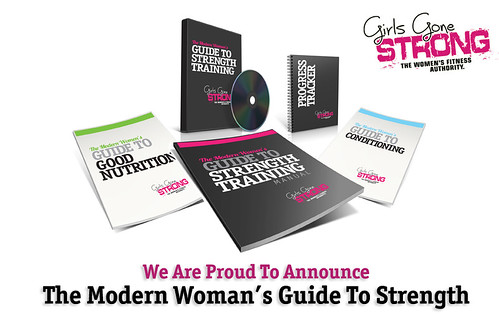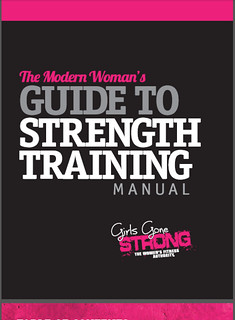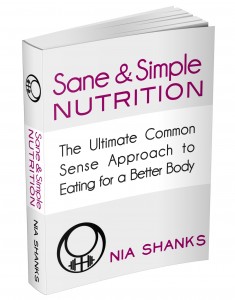Note from TG: Today’s post comes courtesy of Molly Galbraith. She and the rest of the Girls Gone Strong pack released their new resource, The Modern Women’s Guide to Strength Training, today.
Molly was kind enough to write a little sumthin, sumthin to serve as an adjunct to its release.
Enjoy – it’s a doozy!
If you read Tony’s site much (which obviously you do because you’re reading this) you know that he’s a man that’s passionate about a few things:
- Deadlifting
- Eating dead animal flesh
- Anything that has to do with un-doing the “work” of Tracy Anderson
So obviously, I’m going to talk about all 3 of these things today because Tony promised that if I did, he’d film a video of himself doing an Irish jig while wearing a kilt, fanny pack, fairy wings, and the clogs that he hasn’t got much use out of lately (he’s been busy).
So yes, I’ll be covering these topics today, namely #3.
Today I’ll be telling you the 3 reasons why your female clients aren’t getting the results they’re looking for… (Assuming that those results are that they want to look and feel amazing and strong).
Let’s get started!
1. Your Programming is Poor or Incomplete.
I know what you’re thinking:
“My programming’s awesome! My female clients squat and deadlift and do push-ups and all kinds of awesome stuff.”
That’s great. I’m super excited that your clients do those movements. That’s a great starting point, but there are a few things to ask yourself:
– Do you asses all of your clients as soon as they come in the door? Do you observe their posture, their body awareness, and their capability to perform basic movement patterns?
– Do you start your clients off with the basics of each of those movement? Do they perform squats and hinge movements with just their body weight at first? Do they start with incline push-ups so they could really master the movement pattern? Do you set them up for success at the beginning by building an awesome foundation? Or did you have them doing Barbell Back Squats on their first day?
– Is their programming tailored specifically towards what you found in their assessment? For example, if a female client has an exaggerated anterior pelvic tilt are you including more hip, hamstring, and glute dominant exercises that quad/knee dominant exercises? Are you doing a lot of anterior core stability and strength work with them?
Hopefully the answer to all of these question is yes. If it is, you’re *thisclose* to being a Rock Star. But I have a few more for you.
– Have you ever talked with your clients about the importance of breathing? Are there any breathing drills in their workout, even just to cool down at the end?
– Does your client Foam Roll or do other soft tissue work for at least a couple of minutes before their training session?
– Does your client perform a solid Dynamic Warm-up before every workout?
– Does your client do intelligent Energy Systems Training (i.e. cardio)? Also known as “not dumb shit?” This is generally a mix of short High Intensity Interval Training (HIIT) sessions and Moderate Intensity Cardio (MIC) with their heart rate in the 120-150 beats per minute range 1-2x each throughout the week.
All of these things should be included in your female client’s training programs in order to get them the best results with the least amount of time and effort. If not, you’re leaving something on the table.
2. You’re pushing your clients in the wrong ways.
Let me start by saying that I have zero problems with training hard and pushing my clients hard. But it’s important that your client is properly prepared to be pushed, and there are ways to do it, and ways that just don’t make any sense.
Some examples:
A female you’ve been training for a year who has awesome deadlift form and you want to see what she can deadlift for a heavy triple? Awesome.
Seeing how many Burpees your client can do before they puke, pee, cry, or fire you? Not awesome.
Helping your client eek out a couple really tough reps on Dumbbell Bench Press and teaching her to “strain” a bit? Awesome.
Bragging to your friends that your client could hardly walk for four days after being trained by you? Not awesome.
Having your client really push herself on her last couple of prowler trips and try to beat her previous best? Awesome.
Making your client do 100 Box Jumps or Jump Squats because you think its “cool” to make her legs feel like jelly? Not awesome.
Prepare your clients to be challenged appropriately, and I won’t come kick you in the shin.
Note from TG (regarding Molly’s “kick you in the shin” comment): you DO NOT want to make Molly angry. Trust me. Look at her in the picture above. That’s the face she made after being told her boyfriend adopted a kitten for her.
LOL – I’m just kidding. Molly is a delightful human being.
But seriously, don’t piss her off.
3. Your clients are not recovering properly.
As their trainer, it’s your job to help your clients get the best results possible in the gym.
As an above-average-intelligence-trainer (I mean hey! You’re reading Tony’s blog aren’t you?) I expect you to know that your client’s success is directly correlated to how well they can recover from their overall stress load – meaning not just what they do in the gym with you, but what’s going on in their life, in general.
The more life stress they have, they less they need to be doing in the gym unless they have tons of time to sleep, eat nutrient dense food (like dead animal flesh), and recover.
If you’re not talking to your clients about recovery, you’re doing them a major disservice. Before they start training with you, it’s important to help them understand that they get better/stronger/fitter when they recover from, and adapt to stressors, not while the stressor is being applied.
Talk with them the importance of these things:
– Eat nutrient-dense, whole foods 80-90% of the time.
– Manage their stress effectively.
– Get moderate amounts of sunshine regularly.
– Get 7-9 hours of sleep in a cold, dark room every night.
– Use recovery modalities such as massage or other soft tissue work, Epsom salt baths, low to moderate intensity cardio, contrast showers, etc.
And your female clients will be on their way to looking and feeling better than ever.
Hi, it’s me Tony. So how’d you stack up? Are you making these mistakes with your clients, or are you absolutely killing it?
I hope you’re killing it, of course. But on the off chance that you might have been missing a thing or two, you should definitely check out an incredible new resource from Molly and the rest of the Girls Gone Strong crew (you know, The Women’s Fitness Authority) that discusses ALL of these issues, and then some.
The Modern Women’s Guide to Strength Training

I can’t tell you how excited I am to endorse this fantastic resource, as I feel it’s a product that will help a lot of women finally understand the merits of strength training and how strength is a good thing.
More importantly: it’s a manual designed for women written by women.
I know many of you are wondering what’s included. Here’s a brief synopsis.
– The Modern Woman’s Guide To Strength Training Getting Started Guide – this program comes with a LOT of information, but the getting started guide will walk you through it step-by-step.
– The Modern Woman’s Guide To Strength Training Manual – what is strength training, why is it important, a glossary of terms, and information about recovery, sleep, and stress management.

– The Modern Woman’s Guide To Strength Training Programs – three 16 weeks training programs for beginners, intermediates, high-level intermediates (with multiple options for every single exercise in case you want to make a substitution).
– The Modern Woman’s Guide To Strength Training Video Library – 90 minutes of high-definition video with me coaching GGS co-founder Alli McKee through 70 exercises. I will discuss proper – form, as well as common mistakes and how to correct them.
– The Modern Woman’s Guide To Strength Training Exercise Glossary – a print version of the video library for quick reference if you forget how a particular exercise is performed.
– The Modern Woman’s Guide To Strength Training Progress Tracker – a progress tracking guide where you can track measurements, weight (if desired), mood, sleep, stress level, strength level, energy level, etc. so you can get a comprehensive picture of what’s going on with your body.
In addition, for those looking for guidance on the nutrition side of things, The Modern Woman’s Guide To Good Nutrition Package written by Dr. Cassandra Forsythe, PhD, RD, CSCS, gym owner, and co-author of The New Rules Of Lifting For Women, and The Women’s Health Perfect Body Diet will also be available.
Included in this package is:
– The Modern Woman’s Guide To Good Nutrition Manual – 18 chapter manual with everything you need to know from determining calorie level and macronutrient ratio to recommended food sources and beverages, to what medications may be preventing fat loss.
– The Modern Woman’s Guide To Good Nutrition Meal Plan – Cassandra recognizes that every woman is different and needs a different nutrition structure to be successful. She put together done-for-you meal plans for fat loss and maintenance at multiple calorie levels, as well as a FODMAP plan for women with digestive issues, a Paleo meal plan at multiple calorie levels, and outlined multiple If It Fits Your Macros (IIFYM) plans for those who prefer that type of plan.
In a nutshell: this resource is the bomb-diggidy, and covers every base imaginable. So what are you waiting for? Click the link below to get started (you only have a few days to take advantage of the introductory offer).
—> The Modern Women’s Guide to Strength Training<—
About the Author
Molly Galbraith is co-founder of Girls Gone Strong, a movement dedicated to helping women improve their physical strength, mental strength, and strength of character through strength training.
She is also co-founder J&M Strength and Conditioning, a private studio gym in Lexington, Kentucky.
Her mission is to, ”Help women discover and accept what their best body looks and feels like, with minimal time and effort, and once they discover that, help them have grace and compassion about it.”



